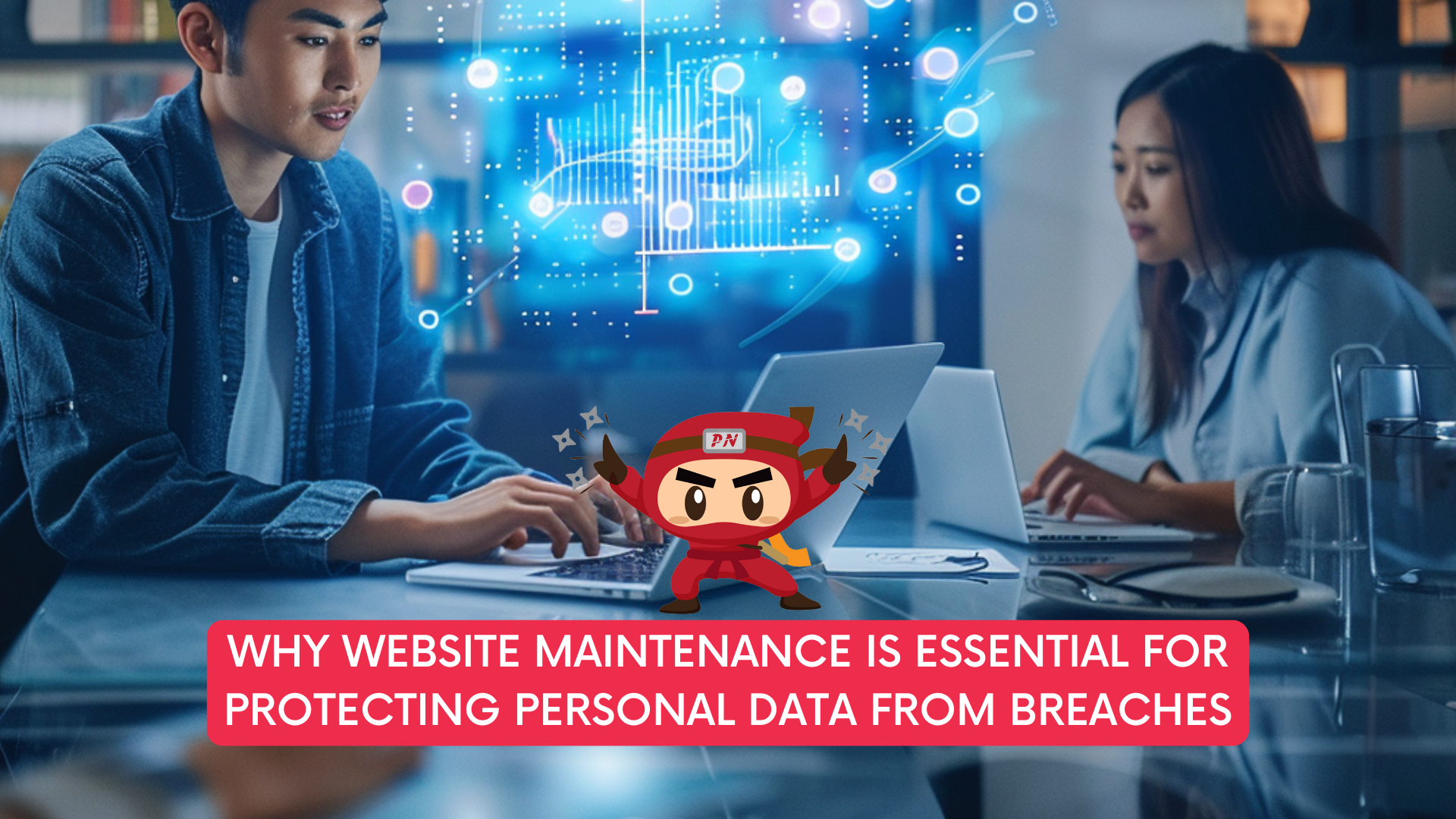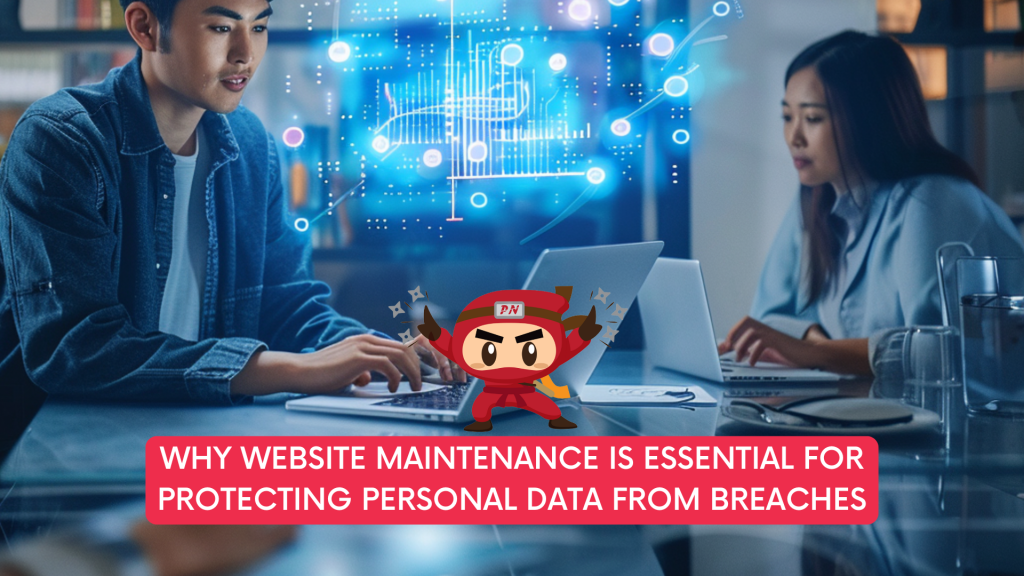KEEP IN TOUCH
Subscribe to our mailing list to get free tips on Data Protection and Cybersecurity updates weekly!







In today’s increasingly digital world, websites serve as the primary touchpoint between businesses and their customers. Whether it’s for e-commerce, service offerings, or information sharing, websites handle a vast amount of personal data, from contact details to financial information. This makes them prime targets for cyberattacks. Therefore, maintaining your website is not just about ensuring it runs smoothly but also about safeguarding the sensitive data it handles.
Regular website maintenance, which includes updates and security checks, plays a pivotal role in protecting against data breaches and ensuring that your website is resilient against evolving threats. Failing to maintain your website properly can expose your business to security vulnerabilities, putting personal data at risk and damaging your brand’s reputation.
In this article, we’ll explore the importance of website maintenance, particularly for sites that handle personal data, and how regular updates and security measures can protect against data breaches.
Website maintenance involves a series of activities that ensure the optimal performance, functionality, and security of your website. This includes:
For websites that handle personal data, the stakes are even higher. Let’s take a closer look at the importance of regular updates and security checks.

With cyber threats becoming increasingly sophisticated, websites handling personal data—such as customer names, addresses, payment information, and more—are prime targets for hackers. Maintaining your website with regular updates and security checks is one of the most effective ways to protect personal data from breaches. Here’s why:
Cybercriminals are always on the lookout for vulnerabilities in website software. When a developer releases a security update, it’s often in response to a newly discovered vulnerability. Hackers quickly exploit these weaknesses, targeting websites that haven’t been updated.
For example, content management systems like WordPress frequently release updates that patch known security flaws. Failing to install these updates leaves your website—and the personal data it stores—vulnerable to attack. A simple software update can often be the difference between a secure website and a data breach.
Regular updates ensure that your website is protected from known vulnerabilities, reducing the risk of unauthorized access and safeguarding the personal data of your users.
No website is 100% secure, which is why regular security audits are essential. These audits help identify potential risks that may have gone unnoticed during routine operations. They can uncover outdated software, weak passwords, unpatched vulnerabilities, or configurations that put personal data at risk.
By conducting periodic security checks, you can stay ahead of potential threats. For example, many organizations use web application firewalls (WAF) to protect their websites from malicious traffic. During a security audit, your WAF settings can be reviewed to ensure they are up to date and properly configured to defend against the latest threats.
By identifying and addressing these risks proactively, security audits play a critical role in preventing data breaches and ensuring that personal data remains safe.
Despite your best efforts, breaches can still occur. In such cases, having regular data backups can be a lifesaver. If your website is compromised or data is lost, you can restore the affected systems quickly from a backup, minimizing the impact on your users.
For websites handling personal data, it’s especially important to back up databases containing sensitive information. However, backups themselves must be stored securely to prevent unauthorized access. Encrypting backups and storing them offsite or in secure cloud storage ensures that even if your primary system is compromised, the backup remains protected.
In addition to protecting against breaches, data backups also help recover from other incidents, such as hardware failures, accidental deletions, or ransomware attacks.

When personal data is transmitted between your website and its users, it must be encrypted to prevent interception by hackers. SSL (Secure Socket Layer) certificates encrypt this data, ensuring that even if someone intercepts the communication, they can’t read the data.
Maintaining an up-to-date SSL certificate is a crucial aspect of website maintenance. Without it, sensitive data like credit card numbers, login credentials, and personal information could be exposed during transmission, leading to potential data breaches. An expired or misconfigured SSL certificate could also lead to security warnings on your website, driving users away and eroding trust.
Ensuring that your SSL certificate is valid and properly configured is a simple but effective way to protect personal data and boost user confidence.
Many jurisdictions have strict data protection regulations that require organizations to implement security measures to protect personal data. Regulations such as the General Data Protection Regulation (GDPR), the California Consumer Privacy Act (CCPA), and the Health Insurance Portability and Accountability Act (HIPAA) impose penalties on organizations that fail to adequately protect personal data.
Regular website maintenance ensures that you stay compliant with these regulations. Security audits, updates, and backups are all key components of a comprehensive data protection strategy. By maintaining your website properly, you can demonstrate your commitment to data security and avoid the hefty fines and reputational damage that can result from non-compliance.
Failing to maintain your website can have serious consequences, especially if it handles personal data. Some of the risks include:
To ensure your website remains secure and protects personal data, here are some best practices for website maintenance:
Maintaining your website is not just about ensuring smooth functionality; it’s about protecting the personal data entrusted to you by your users. Regular updates, security audits, and best practices such as data backups and SSL certificates are essential to safeguarding your website against data breaches.
By staying proactive with website maintenance, you can reduce the risk of a data breach, protect your customers’ personal information, and maintain compliance with data protection regulations. In doing so, you not only protect your business from costly security incidents but also build trust with your users, ensuring a positive online experience.
Your appointed DPO can work with you on your PDPA compliance, ensuring that there will be policies in place to make sure that the handling of personal data is PDPA compliant.
A Data Protection Officer (DPO) oversees data protection responsibilities and ensures that organisations comply with the Personal Data Protection Act (PDPA). Furthermore, every Organisation’s DPO should be able to curb any instances of PDPA noncompliance as it is the officer responsible for maintaining the positive posture of an organisation’s cybersecurity.
DPOs complement organisations’ efforts to ensure that the organisation’s methods of collecting personal data comply with the PDPA. It also ensures that policies are set in place to make sure that there will be no instances of data breaches in the future.
Don’t wait any longer to ensure your organisation is PDPA compliant. Take our free 3-minute PDPA Compliance Self-audit checklist now, the same “secret weapon” used by our clients to keep them on track. Upon completion, we will send you the results so you can take the necessary action to protect your customers’ data. Complete the free assessment checklist today and take the first step towards protecting your customers’ personal data.